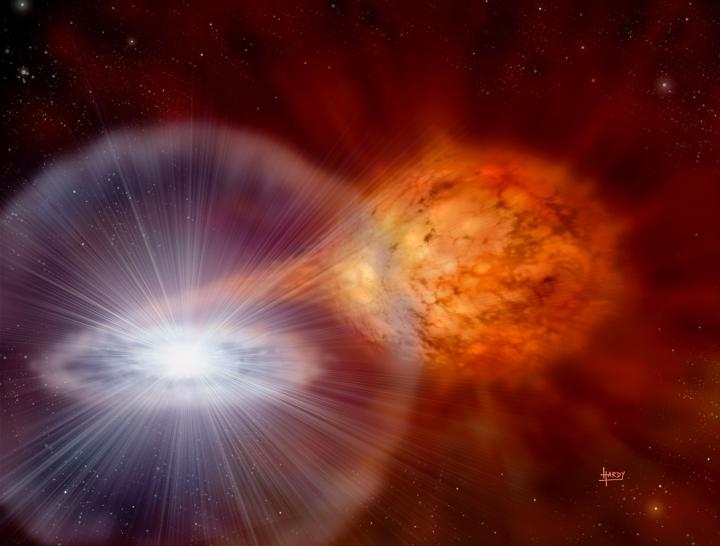Jun 2 2020
Combining theory with both laboratory studies and observations, a research team led by Sumner Starrfield, an astrophysicist from Arizona State University, has determined that a type of stellar explosions, known as classical novae, is the cause for a major portion of lithium in the solar system and the Milky Way galaxy.
 Artist’s interpretation of the explosion of a recurrent nova, RS Ophiuchi. This is a binary star in the constellation of Ophiuchus and is approximately 5,000 light-years away. It explodes roughly every 20 years when the gas flowing from the large star that falls onto the white dwarf reaches temperatures exceeding 10 million degrees. Image Credit: Illustration by David A. Hardy.
Artist’s interpretation of the explosion of a recurrent nova, RS Ophiuchi. This is a binary star in the constellation of Ophiuchus and is approximately 5,000 light-years away. It explodes roughly every 20 years when the gas flowing from the large star that falls onto the white dwarf reaches temperatures exceeding 10 million degrees. Image Credit: Illustration by David A. Hardy.
The study outcomes were recently reported in the Astrophysical Journal from the American Astronomical Society.
Given the importance of lithium to common uses like heat-resistant glass and ceramics, lithium batteries and lithium-ion batteries, and mood altering chemicals; it is nice to know where this element comes from. And improving our understanding of the sources of the elements out of which our bodies and the solar system are made is important.
Sumner Starrfield, Regents Professor, School of Earth and Space Exploration, Arizona State University
Starrfield is also a Fellow of the American Astronomical Society.
The researchers have determined that a part of these classical novae will continue to evolve until they burst as type Ia supernovae. Such bursting stars turn brighter when compared to a galaxy and can be found at extremely large distances in the universe.
These supernovae are being used to evaluate the evolution of the universe and were used in the mid-1990s to find out dark energy, which accelerates the expansion of the universe. They also generate a major portion of the iron in the solar system and the galaxy, a vital constituent of human red blood cells that carry oxygen all through the body.
Classical Novae
Commonly known as the “Big Bang,” the formation of the universe primarily led to the formation of the elements hydrogen, helium, and a little lithium. All the other chemical elements, such as a major portion of lithium, are formed in stars.
Classical novae are a type of stars including a white dwarf (a stellar remnant with the size of Earth but the mass of the sun) and a larger star closely orbiting the white dwarf.
Gas from the larger star shifts to the white dwarf, and when sufficient gas gets accumulated on the white dwarf, an explosion, or nova, takes place. Every year, about 50 explosions occur in the Milky Way galaxy, and astronomers across the world observe the brightest ones in the night sky.
Simulations, Observations, and Meteorites
The researchers of this study employed various methods to identify the amount of lithium generated in a nova explosion. They integrated computer predictions of the way lithium is produced by the explosion, how it is ejected, and what would be its total chemical composition, together with telescope observations of the ejected gas, to measure the composition.
Using his computer codes, Starrfield simulated the explosions and collaborated with co-author and American Astronomical Fellow Charles E. Woodward from the University of Minnesota and co-author Mark Wagner from the Large Binocular Telescope Observatory in Tucson and Ohio State to acquire data on nova explosions with the help of orbiting telescopes, ground-based telescopes, and SOFIA—the Boeing 747 NASA observatory.
An understanding about the nuclear reactions inside stars that were crucial to solving the differential equations required for this study was offered by study co-authors and nuclear astrophysicists Christian Iliadis from the University of North Carolina at Chapel Hill and W. Raphael Hix from the Oak Ridge National Laboratory and the University of Tennessee, Knoxville.
Our ability to model where stars get their energy depends on understanding nuclear fusion where light nuclei are fused to heavier nuclei and release energy. We needed to know under what stellar conditions we can expect the nuclei to interact and what the products of their interaction are.
Sumner Starrfield, Regents Professor, School of Earth and Space Exploration, Arizona State University
Isotope cosmochemist Maitrayee Bose from ASU’s School of Earth and Space Exploration, who is also a co-author of the study, investigates meteorites and interplanetary dust particles containing tiny rocks that form in stars of various types.
Our past studies have indicated that a small fraction of stardust in meteorites formed in novae. So the valuable input from that work was that nova outbursts contributed to the molecular cloud that formed our solar system.
Maitrayee Bose, Isotope Cosmochemist, School of Earth and Space Exploration, Arizona State University
Furthermore, Bose notes that this study predicts highly specific compositions of stardust grains that form in outbursts of novae and have been unaffected ever since they formed.
“This is ongoing research in both theory and observations,” added Starrfield. “While we continue to work on theories, we’re looking forward to when we can use NASA’s James Webb Space Telescope and the Nancy Grace Roman Telescope to observe novae and learn more about the origins of our universe.”
Journal Reference:
Starrfield, S., et al. (2020) Carbon–Oxygen Classical Novae Are Galactic 7Li Producers as well as Potential Supernova Ia Progenitors. The Astrophysical Journal. doi.org/10.3847/1538-4357/ab8d23.